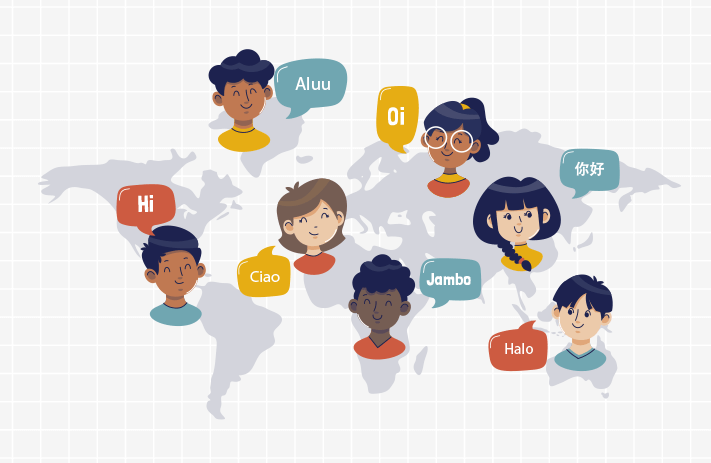
Click the button to start reading
Cross-Cultural Collaboration in the Modern Workplace
Culture shapes our lives to a considerable extent. Everyone is born into a culture of their own, and failing to take this into account could yield misunderstandings and conflicts, which is why it became a crucial topic in the modern workplace.
Our backgrounds define the way we interact with our peers and seniors and define our expectations from social interactions. Being knowledgeable and curious about other cultures doesn’t just help you avoid uncomfortable misunderstandings and flawed assumptions but will also allow you to improve your communication with your colleagues at work.
In this blog post, we’ll explore the intricacies of cross-cultural collaboration, and we’ll take a look at a few useful do’s and don’ts when it comes to making people around you accepted and understood.
Let’s dive right in, shall we?

1. Cultural metacognition?
Cultural metacognition is a term coined by Harvard Business School professor Roy Chua. So, first off, what in the world is metacognition? Cognition typically refers to the process of thinking, perceiving, or reasoning. The easiest way to explain metacognition is “thinking about thinking,” in this particular case, it’s being conscious of the cultural assumptions you make about other people.
Developing this skill is essential in building trust with your colleagues and taking your collaboration to a whole new level.
Okay, but how does one even do that?
Fortunately, there’s a fairly simple analogy that can help us get to the bottom of this term. Imagine that you’re driving in a foreign city. Most people will experience a sense of heightened awareness since they need to take in a lot of details to navigate this new area efficiently. You need to pay attention to road signs, speed limits, means of transportation you’re not used to, and so forth. On the other hand, visiting foreign places can be a fulfilling and illuminating experience.
So fundamentally, cultural metacognition is a heightened sense of awareness when thinking about other cultures, as well as how you interact with people from cultures different from yours. This will invariably enable you to be mindful and respectful of people’s differences and, as a result, ensure better cross-cultural collaboration.
Have you ever noticed that one of your colleagues gets continuously interrupted during meetings? Or that one of your colleagues very rarely makes contact with other people in the office? Consider whether those tendencies relate to their cultural background, their personal characteristics, or a mix of both.

2. Assumptions and value systems
People make assumptions all the time. Very often, these assumptions are incorrect, but, unfortunately, there’s very little we can do about it. This is a feature that we had to learn throughout evolution in order to increase our chances of surviving in hostile environments that we didn’t understand. Assumptions were an extremely important development for people, because they generally require very little thought, allowing us to react quickly.
Can we change that? Not really. At this point, this is just a part of how people operate in the world, and it will take many, many years to undo this if that would ever be necessary, so trying to stop making assumptions is pretty much futile. However, that is not to say that we can’t really do anything about the assumptions we make about the people around us, especially those that come from different cultures.
Something that would actually improve cross-cultural collaboration in your workplace is understanding that you’re prone to assuming things by default, and it’s always a good idea to challenge these preconceptions whenever you can. As a leader, it’s also a good idea to remind the people around you to do the same.
Eliminating erroneous beliefs about people that come from cultures that are different from your own will not only improve morale in your organization but will also enable people to collaborate more efficiently by getting to know each other on a more personal level.
An excellent way to dispel a wide array of misconceptions your colleagues may have about each other is a creating a questionnaire that would cover different critical aspects of their work-related preferences—stuff like the time when they’re most productive, how they prefer to interact with their colleagues, how they’d like to get the feedback, and so forth.
How is this useful? The things you can learn about your colleagues will shed light on their value systems that are partially derived from their cultures.
Fundamentally, a person’s values are expressed through what they prefer to work, how they behave, and how they expect others to behave. Respectively, understanding their values will help you tailor the best approach to collaborating with them and learning about how they prefer to execute tasks and interact with their colleagues.
Value systems contain a number of essential parameters to keep in mind. Here are a few of them:
- Hierarchy—the extent to which people from different cultures welcome or accept a vertical distribution of power in an organization. Some cultures appreciate well-defined leadership roles, and people are expected to follow their managers’ orders. On the other hand, there are cultures that value a flatter distribution of power and questioning management’s decisions is accepted and normalized.
- Ambiguity—the extent to which people are comfortable with uncertainty in their work. Some cultures value risk-taking and trying novel approaches, whereas others are typically inclined towards more structure and choose not to experiment with untested methodologies.
- Individualism—the extent to which people from certain cultures value individual success versus collective success.
- Achievement orientation—a spectrum that reflects the type of achievements a culture is typically drawn to. Some cultures value success, wealth, and self-actualization, whereas others seek to achieve a better quality of life and relationships with the people around them.
- Long-term orientation—the extent to which particular cultures prefer long-term gain versus immediate gains.
It’s crucial to underline that while certain cultures have dominant value systems that define how well they tolerate ambiguity or how individualistic they are, they are but generalizations. It would be unreasonable to assume that everyone from that country will share the same views or values.
So going back to questionnaires—consider wording your questions in a subtle manner that will allow your colleagues to expand on their preferences, ideally on a video call. This insight into their personality and value system will be an invaluable asset when it comes to streamlining collaboration in your team.

3. People view time differently
An essential part of people’s cultural differences in how they choose to deal with time. All of us fall somewhere between monochronic and polychronic behaviors. The former is a preference for working on one task at a time, while the latter is an inclination towards multitasking. Monotaskers typically like to compartmentalize their time in order to start working on a task only after they’ve finished the previous one.
Members of both groups are subject to bias against one another. For instance, people that have a more monochronic attitude can sometimes see their polychronic colleagues as disorganized and even chaotic. In contrast, multitaskers can often be frustrated with monotaskers’ reluctance to jump in an ad hoc meeting to address an urgent problem.
To eliminate misunderstandings and promote a more mindful approach towards people with differing attitudes to time, it’s essential to create an environment where everyone can openly discuss their preferences.

4. Language matters
A substantial part of effective cross-cultural collaboration and leadership in modern organizations revolves around the ability to deliver messages in a thoughtful manner. There’s a wide array of language parameters that can cause issues between people from different backgrounds. The things we have to pay close attention to is our vocabulary and language style, as well as non-verbal behaviors.
1. Language
In the vast majority of cases, international teams use English as a lingua franca (bridge language) in order to communicate with people from different cultural backgrounds.
Language problems may occur if all individuals within a team do not use the same first language. In these situations, for ease of communication, the team often chooses a common language that they can use for group communications. Language differences between individuals can occur at two different levels:
- Vocabulary—the words native speakers use can often be a source of confusion in a cross-cultural workplace. It’s always a good call to tailor your communication in terms of vocabulary, pronunciation, and slang to accommodate your foreign colleagues.
- Style of communication—different cultures have different styles of interacting across hierarchies. Some people are very direct by default, while others choose to be more cordial. The same applies to cultures that choose to be brief in their communication, while others prefer to be expansive.
2. Non-verbal behaviors
Non-verbal behaviors are a critical part of communication. However, unfortunately, there are very few gestures that have the same universal meaning. The same applies to body language. Making eye contact with people can be considered a sign of politeness in some cultures and rude in others. It’s essential to be mindful of these things in order to establish an effective cross-cultural collaboration at work. Of course, taking these things into account at all times can be a daunting task, but at least attempting to do so will surely eliminate a great deal of misunderstandings.

3. Microaggressions
Derald W. Sue, a psychologist that published two books on microaggressions, defines them as: “The everyday slights, indignities, put-downs and insults that people of color, women, LGBT populations or those who are marginalized experience in their day-to-day interactions with people.”
Typically, these behaviors aren’t always intended as an insult, they’re often meant as a compliment, yet they carry a negative connotation that assaults the dignity of marginalized groups. Here are a few examples:
- Asking a gay colleague, “Who is the ‘man’ in your relationship?”
- Choosing to simplify or mispronounce a person’s name because it sounds too foreign or is hard to say correctly.
- Complimenting a non-white coworker on speaking good English.
There is also a type of microaggression relatively common in the workplace called behavioral microaggressions. These are behaviors that assault one’s identity. Here are a few examples:
- Assuming that a Latinx colleague is a service worker.
- Suggesting that a female coworker should smile more.
- Not inviting a disabled coworker to an after-work event because you assumed that they couldn’t participate.
While most of us are willing to learn how to behave in a way that’s accepting and inclusive of people from other cultures or marginalized communities, almost all of us have at one point committed a microaggression. Here are a few things you should take into account when you’ve been called out for doing so:
- Don’t be defensive—while you probably didn’t intend to offend anyone, it’s important to empathize with the person you’ve committed a microaggression against.
- Listen intently—if you happen to insult someone, instead of deflecting by saying that “it was a joke,” consider listening to what they have to say.
- Acknowledge—it’s absolutely critical to recognize and verbally acknowledge that you’ve wronged someone.
- Apologize, but don’t expect to be forgiven—people from minority groups have to deal with microaggressions throughout their entire lives, so it’s only fair to expect that you won’t be forgiven straight away. While what you said seemed like an inoffensive joke to you is an insult they are probably tired of hearing.
The bottom line
Developing cultural mindfulness and making the necessary adjustments when interacting with your colleagues from other cultures is challenging, but this is a critical part of creating an inclusive and diverse environment that’s also productive. Instead of viewing these changes in your behavior as a sacrifice, understand that they are critical in ensuring that the people that come from other cultures feel welcome in the workplace, and it’s one of the important things we can do to work towards creating an equal society.
















